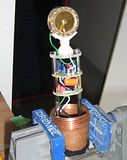Rybow
Well-known member
Alrighty, here are a couple of shots. I have affectionately named this mic "The Pipebomb". The photos aren't that great. Sorry. My space is really dark, so I had to use the flash a bit.
The scariest part of the whole build was replacing the centre wire on the capsule. When I took the capsule out of the 435, I just snipped the wires right at the capsule. I thought I wouldn't be using it again. I used 24 gauge wire because I didn't have anything smaller. I couldn't find any nice brass end caps locally, so I just used some plumbing fittings. Once I paint this sucker and build a head basket, it should look a lot nicer. For now, it works! I said above that the output was low, but it's actually not that bad. Ensemble set at 55db of gain gives me -12dbfs peak -20dbfs RMS on acoustic guitar which is perfect. Going to try this mic in front of my amp soon. Edit: Nope. Can't handle the level of a cranked amp at 1 meter. Asymmetrical clipping galore. Off axis is better, but I think this mic is more suited to acoustic instruments and vocals. For me, it's my new acoustic guitar mic.
Humble beginnings

Almost there

In the mount, ready to go

Good luck with those SDC's tchgtr! I think the hardest part is going to be finding a capsule that fits the body you have. I saw a mic where a guy used the Oktava pad to adapt an 012 capsule to a piece of plumbing pipe, but I can't remember where I saw that. Those 012 capsules can be found on ebay for $50 sometimes.
Edit: Cleaning up pics
The scariest part of the whole build was replacing the centre wire on the capsule. When I took the capsule out of the 435, I just snipped the wires right at the capsule. I thought I wouldn't be using it again. I used 24 gauge wire because I didn't have anything smaller. I couldn't find any nice brass end caps locally, so I just used some plumbing fittings. Once I paint this sucker and build a head basket, it should look a lot nicer. For now, it works! I said above that the output was low, but it's actually not that bad. Ensemble set at 55db of gain gives me -12dbfs peak -20dbfs RMS on acoustic guitar which is perfect. Going to try this mic in front of my amp soon. Edit: Nope. Can't handle the level of a cranked amp at 1 meter. Asymmetrical clipping galore. Off axis is better, but I think this mic is more suited to acoustic instruments and vocals. For me, it's my new acoustic guitar mic.
Humble beginnings

Almost there

In the mount, ready to go

Good luck with those SDC's tchgtr! I think the hardest part is going to be finding a capsule that fits the body you have. I saw a mic where a guy used the Oktava pad to adapt an 012 capsule to a piece of plumbing pipe, but I can't remember where I saw that. Those 012 capsules can be found on ebay for $50 sometimes.
Edit: Cleaning up pics





































